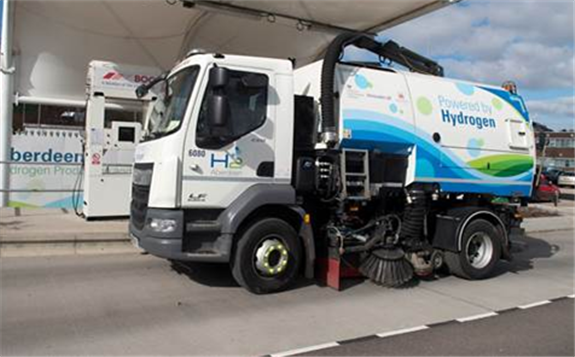More than 14 tonnes of CO2 was saved in a two-year trial involving just 11 urban trucks and vans running on green hydrogen dual fuel. That is one result of the Low Emission Freight and Logistics Trial (LEFT) project to investigate the practical deployment of hydrogen powered vehicles in the UK.

With between 20-45% of the diesel fuel being displaced by green hydrogen on the various vehicles, the HyTIME project concluded that with the appropriate hydrogen infrastructure, fleet wide roll-out could provide a huge and timely step change in overall fleet emissions.
In the trial, ULEMCo—the company pioneering the adoption of ultra-low emission hydrogen fuel with its partners—converted four refuse trucks, a road sweeper, a patient transport vehicle, four panel vans and a refrigerated van to run on hydrogen as a dual fuel.
During the trial period, nearly 60,000 km were covered and 1619 kg of hydrogen used. One of the partners working with ULEMCo on the HyTIME project was Aberdeen City Council, which took delivery of the world’s first hydrogen dual fuel road sweeper, as well as two Merc Econic refuse trucks, and has gone on to put several more of these on the roads since.
The demonstrated benefits would have been even more significant had the hydrogen infrastructure been more developed. Project data show that the CO2 saving would have been about 45 tonnes per annum across the 11 vehicles. When the vehicles were not using hydrogen in their day to day operations, the principal reason was the lack of available refueling facilities.
Other conclusions from the work were that tail pipe emissions in a number of specific applications such as refuse trucks were significantly better than the EURO 6 base vehicles, with the NOx emissions reduced by between 29-85% across the range of cycles tested. If deployed full time, the vehicles would not only save carbon but also provide improvements to local air quality. At least 96% of the hydrogen used in the trial came from on-site electrolysis from renewable electricity.
The drivers and operators confirmed that, from an operational point of view, the vehicles ‘fitted well with their daily operation’, but said that reliability of the hydrogen infrastructure and fuel availability needed to be improved to get the most from the technology.
ULEMCo and its partners believe that hydrogen technology should be seen as a key part of the UK’s energy strategy and post COVID-19 recovery plans. The company is seeing latent demand across a number of fleet customers that would help build the base loads and the commercial case for faster development of the fuelling infrastructure.
The LEFT work was partly funded by the Office for Low Emission Vehicles (OLEV) in partnership with Innovate UK, and included independent testing of the overall emissions of a number of the vehicles in the project.